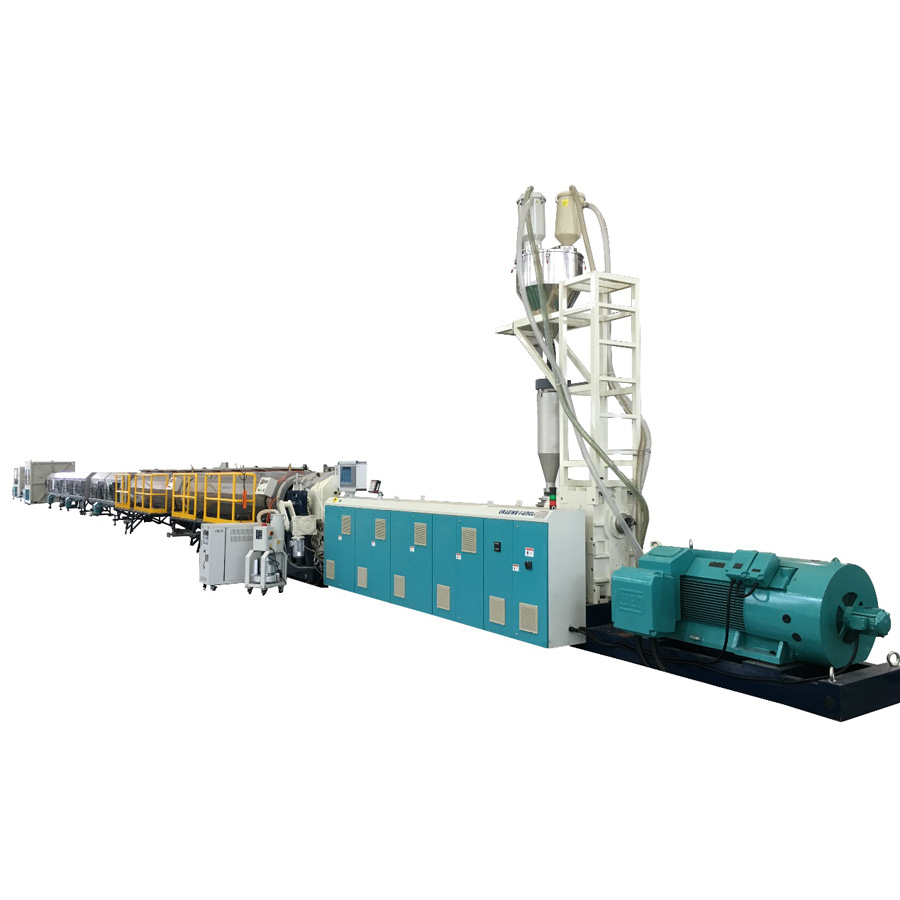- English
- Español
- Português
- русский
- Français
- 日本語
- Deutsch
- tiếng Việt
- Italiano
- Nederlands
- ภาษาไทย
- Polski
- 한국어
- Svenska
- magyar
- Malay
- বাংলা ভাষার
- Dansk
- Suomi
- हिन्दी
- Pilipino
- Türkçe
- Gaeilge
- العربية
- Indonesia
- Norsk
- تمل
- český
- ελληνικά
- український
- Javanese
- فارسی
- தமிழ்
- తెలుగు
- नेपाली
- Burmese
- български
- ລາວ
- Latine
- Қазақша
- Euskal
- Azərbaycan
- Slovenský jazyk
- Македонски
- Lietuvos
- Eesti Keel
- Română
- Slovenski
- मराठी
- Srpski језик
How to effective use Bulk Extrusion Line of PE Pipe
2025-01-24
To effectively use a Bulk Extrusion Line for PE Pipe, it’s essential to optimize every aspect of the process, from preparation and operation to maintenance and quality control. Below are strategies for maximizing efficiency, quality, and productivity:
1. Pre-Production Preparation
Material Preparation
Raw Material Quality: Use high-quality polyethylene (PE) resin with the required grade (e.g., PE80, PE100) for your specific application.
Pre-Drying: Ensure the resin is adequately dried (if needed) to remove moisture and prevent defects like bubbles or weak spots.
Additives: Use appropriate stabilizers, colorants, or UV-protectants to enhance pipe properties.
Equipment Inspection
Extruder Setup: Verify that the extruder, die head, and downstream equipment are set up correctly for the pipe dimensions and specifications.
Calibration Sleeve: Ensure the sleeve is designed for the specific pipe diameter and wall thickness.
Cooling System: Confirm that water or air cooling systems are operational and calibrated for optimal performance.
Vacuum Tank: Inspect vacuum settings and seals to ensure proper pipe sizing during the calibration process.
2. Optimizing the Extrusion Process
Extruder Parameters
Temperature Profile: Maintain a consistent heating profile across all zones (feed, compression, and metering zones) to avoid material degradation or uneven flow.
Screw Speed: Optimize screw speed to ensure a steady melt flow without overheating or over-shearing.
Melt Pressure: Monitor melt pressure to avoid stress variations that can lead to pipe inconsistencies.
Calibration and Cooling
Vacuum Calibration: Adjust vacuum levels in the calibration tank to achieve precise pipe dimensions.
Cooling Time: Optimize cooling length and time to allow the pipe to solidify uniformly without deformation.
Water Temperature: Maintain consistent cooling water temperatures to avoid thermal stress or cracks.
Puller and Cutter
Pulling Speed: Synchronize the puller speed with the extrusion speed to prevent stretching or compression of the pipe.
Cutting Accuracy: Use automated cutters for consistent pipe lengths and smooth edges.
3. Quality Control
Dimensional Checks: Continuously monitor pipe diameter, wall thickness, and ovality using inline measurement systems.
Surface Quality: Inspect the pipe for defects such as scratches, bubbles, or discoloration.
Mechanical Properties: Periodically test samples for tensile strength, elongation, and impact resistance.
Hydrostatic Testing: Conduct pressure tests to ensure the pipe meets required standards.
4. Maintenance and Troubleshooting
Routine Maintenance
Extruder Screw and Barrel: Regularly clean and inspect for wear to prevent inconsistent melt flow.
Die and Mandrel: Remove buildup to ensure smooth material flow and precise pipe shaping.
Cooling System: Clean water tanks and replace filters to maintain efficient cooling.
Troubleshooting Common Issues
Wall Thickness Variations: Adjust die settings or vacuum levels to achieve uniform thickness.
Surface Defects: Check raw material quality, melt temperature, and die cleanliness.
Ovality or Warping: Ensure consistent pulling speed and even cooling distribution.
5. Efficiency Improvements
Automation: Use PLC systems to automate temperature, pressure, and speed adjustments for consistent operation.
Inline Monitoring: Install real-time monitoring systems to detect defects early and reduce waste.
Energy Efficiency: Optimize heater bands, motor drives, and cooling systems to reduce energy consumption.
6. Worker Training and Safety
Skill Development: Train operators on equipment operation, process optimization, and troubleshooting.
Safety Protocols: Implement and enforce safety measures, such as emergency stops, PPE, and equipment guards.
7. Post-Production Handling
Storage: Store pipes in a shaded, dry area to prevent UV degradation or warping.
Packaging: Use appropriate bundling and protective coverings for transportation and delivery.
8. Continuous Improvement
Process Analysis: Collect data on production rates, defect rates, and energy usage to identify areas for improvement.
Technology Upgrades: Invest in advanced extruders, cooling systems, or monitoring tools to enhance efficiency and quality.
Feedback Loop: Gather customer feedback to refine production processes and meet market demands.
Conclusion
By focusing on process optimization, regular maintenance, quality control, and worker training, you can maximize the effectiveness of your PE pipe extrusion line. This ensures high productivity, reduced waste, consistent quality, and long-term profitability.




